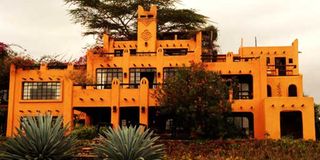The 'most photographed house in Africa’ is slated for demolition. Sign the petition to save it.

African Heritage House PHOTO: Luis Franceschi
What you need to know:
- I want to show people that they should look first for inspiration from their own continent. My goal is to make Heritage House into a trust for the people of Kenya.
- It’s not just Alan Donovan’s house; it’s a museum. There are musical instruments, woodcarvings, fabrics, West African artefacts, and much more.
Journalist Andrew Hilliar of FRANCE 24 visited the African Heritage House and interviewed Emma Too and Alan Donovan, who are fighting to save it. The article below was published some days ago. I reproduce it here with the contributors’ consent.
Kenyans are rallying online to save Nairobi’s legendary ‘Heritage House’ from being demolished to make way for a modern railway line. The House – which is claimed to be themost photographed in Africa– is a museum of ancient wonders that showcases the continent’s extraordinarily rich past.
African Heritage House was built by American-born Alan Donovan. It stands overlooking Nairobi National Park; inside, roughly 6,000 pieces of African art from around the continent are on display. Activists say the house should be considered a national heritage site.
Yet the government’s latest project to boost Kenya’s ailing infrastructure has left African Heritage House at risk of being demolished.

African Heritage House PHOTO: Luis Franceschi
Under the current plans, a new railway linking the capital with the port city of Mombasa would cut right through the house – skirting Nairobi National Park and leaving the house earmarked for demolition.
Donovan told FRANCE 24 that the development comes as the Kenyan government wasactively consideringmaking the house a protected site.
“Heritage House is based on the mud architecture of Africa: most African countries are represented. I give tours of the house, offer overnight stays, and host events, like weddings.
It’s unique in the world. It's very difficult to find these crafts and artefacts nowadays, because many of the people that made themdon't make them anymore. The whole premise is to show people how they can live by taking inspiration from African architecture and décor, and by not importing things that are foreign – like so many people sadly do here.
I want to show people that they should look first for inspiration from their own continent. My goal is to make Heritage House into a trust for the people of Kenya. We would have students in African studies every year that would be living there and doing research on the artefacts. But while one side of the government considers making the house a protected site, the other side wants to build a railway line through it.

African Heritage House PHOTO: Luis Franceschi
Emma Too is a former model for African Heritage, the company that Alan founded together with the late Joseph Murumbi, former Vice President of Kenya, to showcase African art and crafts, and a frequent visitor of African Heritage House. She has started an online campaign to save it.
"Since I once worked for African Heritage, someone sent me an article explaining what the government’s plans were. I thought it was outrageous – why can’t the government make an alternative route? We live on a continent so divided by tribes and problems, but this is a collection that brings cultures together under one roof.
People who don’t have the opportunity to travel around Africa can go to Heritage House and learn about African culture there. It’s not just Alan Donovan’s house; it’s a museum. There are musical instruments, woodcarvings, fabrics, West African artefacts, and much more.
So I decided to create a hash tag –#SaveAfricanHeritageHse– to rally Kenyans on Twitter to support the cause. We want to make it marked as a national heritage site by the cultural ministry, that way it would be protected.
I understand why the government wants to build a new Standard Gauge Railway. This railway would be much more modern. The old one was built by Indian labourers more than 100 years ago. So they’re rebuilding the railway to provide a link to the coastal ports.
With a more modern infrastructure they can transport cargo. However, we need to be able to make compromises. We shouldn’t promote progress by destroying our heritage. The house already has the old railway line in front of it, but the new railway would go right through it.”

African Heritage House PHOTO: Luis Franceschi
Andrew Hilliar, Emma Too and Donovan are right. African Heritage House is one of those artistic icons that future generations have a right to enjoy. They will find there all the vanished art their predecessors cherished. They will feel the nostalgia the Italians feel when contemplating the rundown Coliseum and the Leaning Tower of Pisa, or Egyptians the Gates of Memphis, or Spaniards the Sagrada Familia in Barcelona.
It is strange, perhaps absurd or impractical, but every society needs nostalgia over those strange treasures. Future generations will judge harshly anyone who destroyed art, even in the name of development.
I’ve written before that the railway project cannot be stopped because of one house. But this is no ordinary house. The saddest part is that it is not necessary to bring down the house. The Chinese engineers could easily bypass it. It only requires a word from the President, and a little bit of negotiation between the contractor and the KWS.

African Heritage House PHOTO: Luis Franceschi
Can this house be saved?
Write a comment below, visit the house, sign the petition at https://secure.avaaz.org/en/petition/President_of_Kenya_SAVE_AFRICAN_HERITAGE_HOUSE/?pv=14.
Visit the Facebook page and tweet #SaveAfricanHeritageHse .
Dr Franceschi is the Dean of Strathmore Law School. [email protected] Twitter: @lgfranceschi





